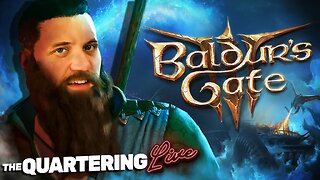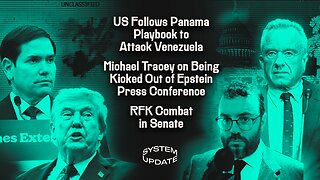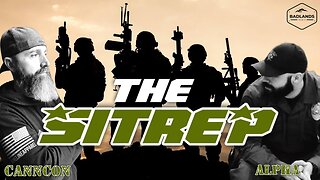Premium Only Content

Pure Chaos: Most DANGEROUS Drug Cartels
Make sure you like the video and FOLLOW our channel for more true crime stories 👇👇
https://rumble.com/c/c-3219400
Among the most dangerous cartels to ever exist was the Los Zetas. Born in 1997 as enforcers for the Gulf Cartel, Los Zetas was founded by Osiel Guillén, who handpicked around 30 alumni from Mexico's special forces. Authorities once described them as "the most technologically advanced and sophisticated" cartels in history.
Instead of relying on corruption like its competitors, Los Zetas used fear as a weapon, seizing territory through torture, beheadings, and massacres. The cartel's footprint extended to 405 Mexican municipalities, more than double of their rivals’. In 2010 alone, Zetas executed 72 migrants in Tamaulipas, which was followed by 2011 attacks in San Fernando and— all in all, 245 lives. The cartel broke in 2012, splitting into two rival clans.
Next on our list is the infamous Medellín Cartel from Colombia. Led by THE Pablo Escobar, it was once responsible for 80% of the cocaine in the US in the 70’s and '80s. This cartel was not just a drug trafficking organization— but a multinational empire building its kingdom on murder and political corruption.
Escobar had one cold philosophy, "Plata o Plomo"— silver or lead. Simply put, officials could either accept bribes or face bullets. His reign resulted in the death of countless politicians, cops, journalists and civilians. Though Medellín was disbanded after Escobar's death in 1993, its legacy continues to echo today.
The cartel world never leaves a power vacuum unfilled. As the Medellín Cartel fell, the Sinaloa Cartel rose to power. This group is synonymous with one figure– Joaquín Loera, known to the world as "El Chapo." This man steered Sinaloa to dominance, using tunnel smuggling and widespread bribes to seize control of the drug trade.
During the late '70s and 80s, the Sinaloa Cartel worked with the Medellin Cartel, establishing huge cocaine routes to the US through land, sea and air. El Chapo also won territory from other cartels during the Mexican government's war on drugs, which brought more violence to the region.
El Chapo’s reign caused the US and Mexico to tighten their nets, leading to his eventual capture. But despite his arrest, the Sinaloa Cartel remained formidable. Experts described it as "Mexico's top crime group."
Emerging from this chaos in 2010 was the Jalisco New Generation Cartel, or CJNG. This group was notorious for its shocking violence. Machine guns, grenade launchers and even an RPG against a military helicopter are testament to the group's ruthlessness.
CJNG's battles with other cartels have caused untold devastation. Among their numerous killings was the June 2020 murder of a Jalisco judge and his wife. Yet, despite the government's pressure on their front companies and bank accounts, CJNG's power was forecast to grow. In the regions they control, CJNG implemented a pseudo-state model, offering protection and social services to locals. To many, they have become the go-to “government”, often more reliable and present than the actual offices.
Finally, let's journey to the Far East, where the Golden Triangle presents another threat. Comprising parts of Myanmar, Laos and Thailand, the region has been a notorious hotspot for opium trade. At the helm of this was a warlord of the Shan United Army, Khun Sa the "Opium King".
Through the 70s and 80s, this man controlled a vast opium empire. Khun Sa positioned himself as a freedom fighter for the Shan people, yet the violence that trailed his operations told a different story. He commanded a private army of thousands, enforced his rule with force, and used the impoverished Shan State as a cover for his narcotics empire. There were times when he forcibly recruited locals, including children, into his ranks. Many were coerced into labor or used as human shields in conflicts. And resisting villages were destroyed.
While opium brought immense wealth, it was at the expense of the local population. This pursuit of power led to widespread poppy cultivation, which caused deforestation and the death of farmlands - pushing the region's poverty to the edge. This, coupled with a growing addiction among the locals, further ruined the state. Even after his surrender in 1996, the Golden Triangle continued to be a major player in the drug trade, with meth now as its main product.
By recounting these stories, we aim not to glorify their actions but to shine a light on the darkest corners of society, in hopes that awareness might spur action, and that one day, this chronicle of chaos may finally end.
#truecrime #crimedailydose #truecrimechannel #truecrimecommunity #crimedocumentaries #realcrimestory #crime #criminal #crimestory #realcrime #crimedocumentary
-
 10:23
10:23
Crime Daily Dose
10 months agoWho Was Jewish Gangster Mickey Cohen | Crime Daily Dose
155 -
 3:21:36
3:21:36
The Quartering
5 hours agoBaldur's Gate 3 First Playthrough!
41.6K6 -
 6:34:42
6:34:42
Rallied
7 hours ago $5.19 earnedWarzone Solo Challenges
70.5K2 -
 57:40
57:40
MattMorseTV
7 hours ago $9.26 earned🔴Trump just SHATTERED the RECORD.🔴
50.1K87 -
 43:39
43:39
WickedVirtue
4 hours agoLate Night Spooky Plays
29.9K2 -
 2:04:02
2:04:02
Glenn Greenwald
8 hours agoTrump and Rubio Apply Panama Regime Change Playbook to Venezuela; Michael Tracey is Kicked-Out of Epstein Press Conference; RFK Senate Hearing | SYSTEM UPDATE #508
106K130 -
 58:36
58:36
Total Horse Channel
9 hours ago2025 CSI3* A Coruña Porsche - Grand Prix
25.7K -
 2:10:32
2:10:32
megimu32
5 hours agoOTS: Mighty Morphin Power Rangers & the 90s Movie That Defined a Generation
23.7K12 -
 1:14:53
1:14:53
Badlands Media
20 hours agoTHE SITREP Ep. 128: Gun Rights, Sleep Paralysis, and Venezuela Cartel Strikes
42.4K11 -
 2:44:56
2:44:56
BubbaSZN
6 hours ago🔴 LIVE - FORTNITE WITH NEW KEYBOARD
15.5K1